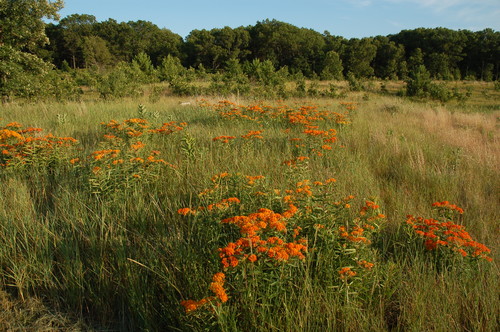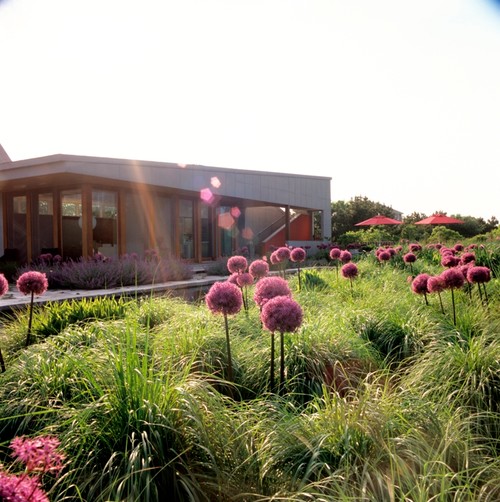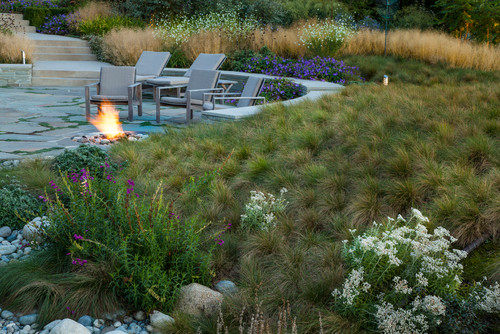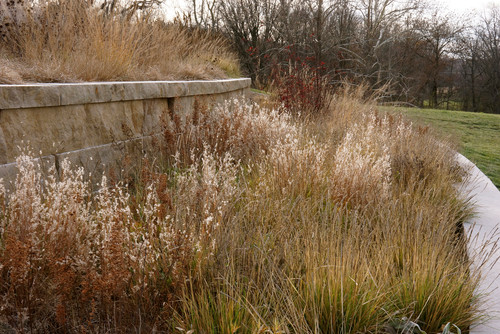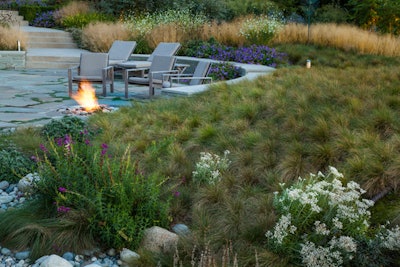
By Benjamin Vogt / Houzz contributor
A matrix planting is designed to emulate the look and function of a natural ecosystem found in the wild. By using plants’ strategies for competition, and placing plants correctly, we can create a sustainable landscape that reduces human inputs, from water to fertilizer to trimming and more — and also cuts down on maintenance.
A matrix garden often combines elements of a meadow or prairie with a tiered and flower-based garden. This means it feels familiar to us while opening up new ecological design possibilities (accepting what looks at first to be a bit messy). Let’s look at what a matrix garden is and how to make it your own.
The Plants of the Matrix
The ground layer. The base of a matrix planting is almost always made up of sedges, grasses, or both. These plants form a background, ground cover or green mulch that visually ties the landscape together and also provides real sustainable bonuses. They outcompete weeds by shading the soil and creating a wildlife habitat in the form of a dense cover.
I tend to use mostly sedges in my matrix base, since they green up early in spring, often before my neighbors’ lawns. Plant those sedges close, 12 inches on center, and in plug form for the base of a thriving, low-care landscape in short order. I then plant sweeps of taller ornamental grasses for their fall color and winter seed heads.
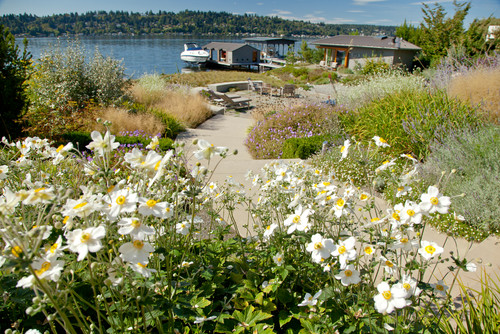
‘Honorine Jobert’ Japanese anemone (Anemone hupehensis ‘Honorine Jobert’) borders a path in this Seattle-area garden.
Photo: Broadhurst + Associates
Seasonal flowers. After the ground layer, look to seasonal displays of diverse flowers to place in clumps or drifts. These plants can be the same height as or taller than the matrix sedges and grasses. Plants that are all the same height provide a softer and less imposing view — especially suited for front-yard gardens where you don’t want a “weedy” look. Seasonal flowers that are a bit taller add an exciting architectural texture that mimics nature even more closely.
You can have just a few flowering plants or have a lot, but generally 50 percent flowers and 50 percent sedges and grasses is a good baseline.
Try including clumps or sweeps of flowers for every season.
- Spring: Dwarf blue indigo (Baptisia australis minor), Hubricht’s bluestar (Amsonia hubrichtii) and golden Alexanders (Zizia aurea)
- Early summer to midsummer: Purple prairie clover (Dalea purpurea), pale purple coneflower (Echinacea pallida) and common boneset (Eupatorium perfoliatum)
- Midsummer: Virginia mountain mint (Pycnanthemum virginianum), black-eyed Susan (Rudbeckia hirta) and butterfly milkweed (Asclepias tuberosa)
- Late summer to early fall: Tall blazing star (Liatris aspera), showy goldenrod (Solidago speciosa) and smooth aster (Symphyotrichum laeve); then follow with aromatic aster (Symphyotrichum oblongifolium), stiff goldenrod (Oligoneuron rigidum) and Maximilian sunflowers (Helianthus maximiliani)
Keep in mind that these plants all have different soil and moisture requirements, as well as various root systems. They should be matched to one another and the other matrix plants.
Sculptural specimens. Small shrubs and trees can be used to add a last, artistic layer to the garden, often to frame a view, serve as a focal point or guide us down a path.
A few larger sculptural perennial forbs, or herbaceous plants, scattered throughout also add interest to the designed wildness. Consider plants such as wild senna (Senna hebecarpa), Joe Pye weed (Eutrochium purpureum), compassplant (Silphium laciniatum) and ironweed (Vernonia spp.).
The Matrix Design
Designing a matrix planting isn’t just about aesthetics and how plant forms play off and against one another. It’s also about how the plants work together above and below the ground.
Competitive plants should be planted among other competitive plants so that they can control one another. This competition may manifest in the aggressiveness of their roots or how quickly they self-sow. Well-behaved clumping plants should be placed among other slow-to-spread plants.
Root structure is another element to be aware of. Place plants with deep taproots among plants with shallower fibrous roots so neither outcompetes the other; each will have its own level to pull resources from.
Matrix gardens tend to look good year-round, given their dense structure and attention to texture, varying heights and interplay among plants. Grasses, sedges, seed heads, barren stalks and empty branches all play key roles in both the garden’s style and wildlife value from summer through winter and on into spring. Wildlife will come to seek shelter, eat seed heads or, in the case of some pollinators, overwinter inside stems or under leaf litter.
If you use plants native to your area, the sustainable and ecological value of your matrix garden will greatly expand. While such a garden may take a bit of research early on — learning how plants compete in the wild and with one another — it will be well worth it in the end. These gardens often are self-guiding, with each year revealing something new. Of course, you may need to thin some plants or make replacements, but that’s part of any garden — and also part of the fun.
EDITOR’S NOTE: This article is from Houzz. Vogt owns Monarch Gardens LLC, a prairie garden consulting and design firm based in Lincoln, Nebraska. He speaks nationally on native plants, sustainable design and landscape ethics.
